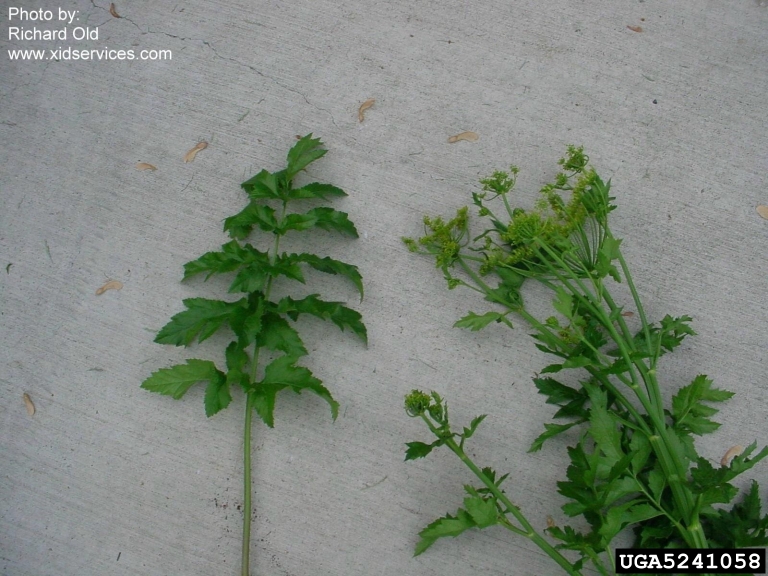Pastinaca sativa L.
Wild Parsnip| Category |
|---|
| Forb/Herb |

Description
Height
Wild Parsnip grows 2-5 feet (.6-1.5 m) tallStem
The upright flowering stalk develops after one or more years of growth. It is branched, hollow except at the nodes, glabrous, and grooved.Leaves
Leaves are alternate and compound with 5 to 11 leaflets. Leaflets are yellowish-green, oblong, coarsely-toothed, and either mitten or diamond shaped. Leaves have a parsnip-like taste and odor, and they appear similar to celery leaves. Long petioles with broad bases encircle the stem at each node. Upper stem leaves are smaller. Petioles have two ridges on the upper surface and three on the lower surface.Flowers
Tiny flowers have 5 yellow petals and are clustered in compound umbels (4-8 inches [10-20 cm] in diameter) at the end of each stem branch from late spring to midsummer.Fruit
Straw colored seeds are less than 1/3 inch (.85cm) long, flat, and winged. The plant dies as seeds mature.Images
Photo: Richard Old, XID Services, Inc., Bugwood.orgMore images of Pastinaca sativa
Life History
Wild Parsnip, also known as Madnip and Yellow Parsnip, is a member of the Carrot family, Apiaceae. Wild Parsnip is a biennial or short-lived perennial that reproduces by seeds. The fleshy taproots can be eaten raw or boiled. Irish beer is often made from the roots of parsnips boiled in water with hops. In the presence of sunlight, the foliage of Wild Parsnip releases a chemical compound that can be highly irritating to human skin and the foraging herbivores. Human safety as well as ecological concerns spur eradication.Wild Parsnip can be distinguished from Carrot family species by its flat-topped compound umbels of yellow flowers, single pinnate compound foliage, and numerous teeth on the leaflets.
Habitat
Wild parsnip grows in roadsides, waste places, old fields, meadows, and along railroad tracks. It grows preferentially on rich loamy soils, particularly calcareous and alkaline soils, but adapts to a wide range of soil conditions.Origin and Distribution
Wild Parsnip is native to Eurasia and occurs in sunny areas with varying degrees of soil moisture. It was originally introduced into North America as a root crop.Other States Where Invasive: AK, AR, AZ, CA, CO, CT, DC, DE, IA, ID, IL, IN, KS, KY, LA, MA, MD, ME, MI, MN, MO, MT, NC, ND, NE, NH, NJ, NM, NV, NY, OH, OK, OR, PA, RI, SC, SD, TN, TX, UT, VA, VT, WA, WI, WV, WY
Federal or State Listed as Noxious Weed, Prohibited, Invasive, or Banned: OH
Sources
Assorted authors. State noxious weed lists for 46 states. State agriculture or natural resource departments.Haragan, P.D. 1991. Weeds of Kentucky and adjacent states: a field guide. The University Press of Kentucky. Lexington, Kentucky.
Southeast Exotic Pest Plant Council. 1996. Invasive exotic pest plants in Tennessee (October 1999). Research Committee of the Tennessee Exotic Pest Plant Council.
Management Recommendations
Mowing seems to encourage the growth and spread of Wild Parsnip by encouraging resprouting, spreading seed, and reducing competition. Cultivating healthy growth of native plants, particularly in a meadow or prairie setting, will result in the decline of Wild Parsnip.Mechanical removal with a shovel chopping the plant just below soil level is very effective. Following prescribed burns, Wild Parsnip rosettes will show up quickly and can be easily spotted and dug.
Parsnip webworms do isolated damage to plants but are not deemed a likely biocontrol agent.
Note: Care should be taken to avoid contact with plant tissue during removal.
